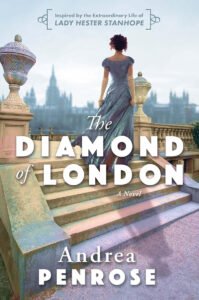Andrea Penrose Unveils the Allure and Intrigue of the Regency Era

Photo: Andrea Penrose, renowned author of Regency historical fiction, showcases her passion for the era and her journey as a writer.
Discovering The Complexity Of Women And The Richness Of Mystery
Andrea Penrose discusses her passion for the Regency era, character development, genre evolution, and the significance of strong female figures in her historical novels.
Andrea Penrose captures the essence of the Regency era like few authors can, weaving historical authenticity with compelling storytelling that resonates deeply with her readers. As a USA Today bestselling author, she has carved a distinctive niche in the literary world, particularly through her acclaimed Wrexford & Sloane mystery series. Penrose’s ability to bring this fascinating period to life is not just a testament to her extensive research but also to her passion for the era’s vibrant culture and dramatic societal shifts.
At Mosaic Digest magazine, we are thrilled to present our exclusive interview with USA Today’s Bestselling Author Andrea Penrose, where she shares insights into her creative process, the inspirations behind her unforgettable characters, and the evolving dynamics of her storytelling. From the strong, unconventional women who defy societal norms to the thrilling mysteries that keep readers on the edge of their seats, Andrea’s work celebrates both historical depth and human resilience. We invite you to explore her journey through the pages of history and discover the intricate tapestry of her writing that unites the past with the present.
Andrea Penrose masterfully combines historical detail with captivating storytelling, creating unforgettable characters that resonate with readers across generations.
Your books bring the Regency era to life with vivid detail. What initially drew you to this time period, and how has your relationship with it evolved over your writing career?
I got my first introduction to the Regency by reading Jane Austen as a young teenager., and as I went on to study its history at university, I fell in love with the era. For me, it’s such a fabulously interesting time and place. Radical new ideas were clashing with the conventional thinking of the past. People were questioning the fundamentals of society, and as a result they were fomenting changes in every aspect of life. Politics, art, music, science, social rules—the old world was turning upside down!
Romanticism was taking hold, bringing a new wave of individual expression.
Technology was disrupting everyday life as the Industrial Revolution began cranking into high gear. Interest in science was exploding as people were suddenly wanting to understand the world around them and how it worked. In so many ways, it was the birth of the modern world, and what really fascinates me is that its challenges, its characters and its conflicts have such relevance to our own times. My research keeps uncovering such interesting parallels to our own present-day issues. So I find those themes are really interesting to develop in my stories.
“For me, it’s such a fabulously interesting time and place. Radical new ideas were clashing with the conventional thinking of the past.” – Andrea Penrose
Lady Charlotte and Lord Wrexford make a compelling duo—what inspired their creation, and how do you approach developing their relationship across a series?
The inspiration came from reading a wonderful book by Richard Holmes called The Age of Wonder, in which he talked extensively about the bond of camaraderie between the artists and scientists of the Regency. They saw each other as kindred souls in terms of wanting to understand the infinite mysteries of Life, and the natural world around them, even though their approaches were quite different. Science was all about empirical observation; art favored imagination and intuition. I found that fascinating, and it inspired the creation of Lord Wrexford, a brilliant chemist, and Charlotte Sloane, a satirical cartoonist who must work under a pen name to hide the fact that she is a woman.
The pairing of Reason and Intuition has been really interesting to develop. Lord Wrexford analyses everything. Charlotte Sloane trusts her intuition. They both are very careful observers, but see things in very different ways. In the first book, circumstances force them into an unwilling partnership to solve a crime. And as the series progresses, they learn from each other, and their own preconceptions and processes begin to change and evolve.
From historical romance to historical mysteries, your genre shift has been seamless. What motivated the transition, and how did it challenge or enrich your storytelling process?
In a romance novel, the traditional core trope revolves around two people falling in love, and somehow overcoming the obstacles that the author creates in their journey before they ultimately get their happily ever after. And I very much enjoyed doing that—Love is an elemental part of the human experience!
Mystery novels focus more on a search for the truth. The protagonists search for clues that will lead to solving a crime or a puzzle, and it’s often a cat-and-mouse game of Good versus Evil to bring criminals to justice. And that journey to resolution requires the protagonists to face their own preconceptions, fears and vulnerabilities, as well as make key decisions about whom to trust. Friendships and love may develop, but they are not the main focus. I really like exploring that complexity of human nature, So my shift from romances to mysteries is because I feel I have a bigger canvas and a richer palette of colors with which to paint my stories.
Readers often praise the strong, unconventional women in your books. What do you hope modern readers take away from Lady Charlotte and the other female characters you write?
The accomplishments of women are too often pushed into the margins of traditional narratives of history, and the female characters in my historical novels pay homage to the courage and grit required from the real-life heroines from the past to ignore the strictures of their societies. I saw an art exhibit of notable Regency personalities called “Romantics & Revolutionaries,” and I was riveted by the women represented, and their stories. They were artists, poets, explorers, chemists mathematicians—but what they all had in common was the courage to defy convention and pursue their passions.
So these real-life Regency heroines help me shape my characters. The women I create would be bored to flinders sitting around drinking tea in the drawing room. They tend to do things they’re not supposed to do. I love that I can be true to history and yet have a real emotional connection with women of our own times, who still face many of the same challenges and prejudices as they look to fulfill their dreams.
You’ve spoken about writing being a journey of curiosity. Has there been a particular discovery or piece of research that completely surprised or delighted you while writing your books?
I love research! Diving down ‘rabbit holes’ is a big part of my creative process. I always come across wonderful arcane facts or quirky inventions which are really fun to weave into my plots. For example, take chocolate—I discovered that there was indeed edible chocolate during the Regency, even though the that common perception is that it didn’t come into being until 1847, when Joseph Fry invented the chocolate bar. So in my Andrea Penrose Lady Arianna Regency mysteries, the heroine is not only a very clever sleuth, but also an expert in concocting sinfully delicious chocolate, which plays into the plots. (Another fun historical fact—Napoleon had a real sweet tooth. That, too, plays into the plots.)
There are too many other examples to list them all here, but another one of my favorite ah-ha inspirations is something I saw at a Sotheby’s auction. It was an exquisitely crafted pocket pistol with gold detailing and jeweltone enamel inlays. But the real highlight was when the trigger was pulled . . . and out popped a tiny bird that flapped its wings and tweeted a few bars from Mozart. How could I possibly resist using that! (It appeared in Sinfully Yours, one of my Andrea Pickens Regency romances.) The dramatic scene has the the villain and hero locked in a life and death struggle . . . the hero slips, allowing the villain to grab up the pistol . . . Yes, that was a fun scene to write!
As the Wrexford & Sloane series continues to grow in popularity, what can readers look forward to next—either thematically or in the development of your central characters?
I think for a series to stay fresh and engaging—both for the author and for readers—one has to keep adding unexpected twists and turns. My upcoming Wrexford & Sloane, Murder at Somerset House, which releases in September has some big surprises . . . so stay tuned!
The Diamond of London by Andrea Penrose
“The Diamond of London” by Andrea Penrose is a captivating historical novel that beautifully brings to life the audacious Lady Hester Stanhope. With impeccable research and rich prose, Penrose explores themes of courage and defiance against societal norms. This enthralling tale of love and adventure is a must-read for historical fiction fans!













